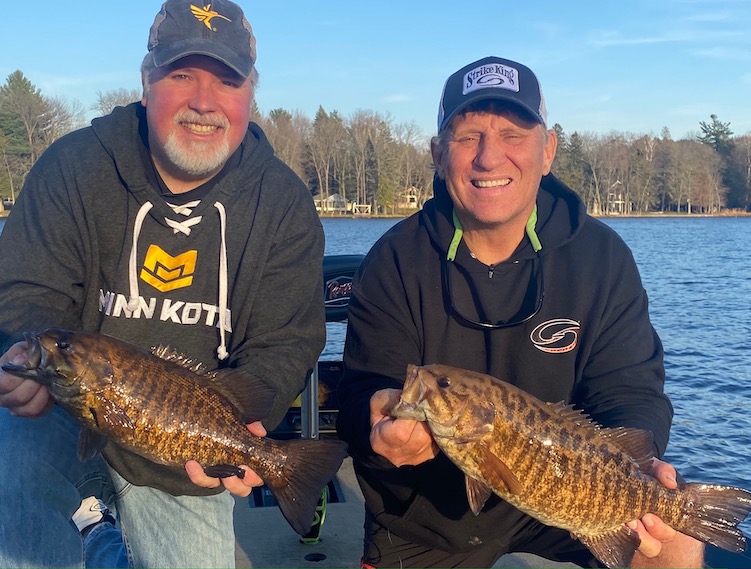News & Stories
More Changes In Fishing
Posted by director on August 23, 2021
MORE CHANGES IN FISHING
By Bob Jensen
For many anglers, the Labor Day weekend marks the end of the fishing season. While there are still lots of outstanding fishing opportunities after Labor Day, many anglers have others interests and hang up the rods and reels. I’ve had conversations with a variety of anglers recently, and they’ve all had some very interesting observations on changes in fishing in recent years. Many of those observations start with a comment to the general idea that, “Man it’s been a hot, dry summer.” Following are some other thoughts.
My fishing friend Mike Frisch is involved in the business of fishing on several levels. Mike has also been an avid observer of fishing trends for several decades. Mike lives near Alexandria Minnesota. Alexandria is a special place when it comes to fishing. There are lots of lakes, lots of fish species, and lots of ways to catch those fish. Mike has noted several changes in fish populations and the ways to catch those fish.
First of all, Mike notes that the waters in many lakes has cleared up significantly due to several factors, but perhaps mostly to the unintentional introduction of zebra mussels. “Zeebs” filter plankton, which makes the water clearer, which allows the sun’s light to penetrate deeper, which enables vegetation to grow in deeper water. The fish are also moving deeper. The areas that ten and twenty years ago were where the fish lived now don’t hold as many fish. They all moved deeper. If you want to catch them, you need to fish deeper also.
Another observation of Mike’s: When it comes to largemouth bass fishing, on many lakes, you’re not going to catch quite as many bass, but they are going to be much larger. Mike has been a successful tournament angler for a long time. Ten years ago, if he had a limit of bass that averaged a little over two pounds, he felt that he would do well. Today, Mike knows that his bass are going to have to average over three pounds if he wants to cash a check. A body of water can sustain a certain amount of fish per acre. Maybe it can have twenty fish that weigh two pounds or ten fish that weigh four pounds. The numbers might change from lake to lake, but the concept is the same. Fishing is still outstanding and many would say that fishing is better now, but it is changing.
Another observation made by several anglers: Conditioning is a factor in fishing success. Conditioning means that fish have developed a reluctance to hit a particular lure, lure presentation, lure color, all sorts of things lure-related. For a long time, very successful anglers have recognized that fish become conditioned, but to many folks who have just started fishing, this is a change that they’ve recognized does exist. Much of the time, we as people don’t always believe in the observations of others until we experience those things ourselves. We might hear about fish becoming conditioned, but until we see it first-hand, we’re not true believers. Just recently a friend told me about finding a school of smallmouth bass and catching several on a crawfish colored jig. When the fishing slowed, my friend tied on a different color and the catching started all over again. To my friend, this occurrence changed his thoughts about fishing. Now, when the fish stop biting, instead of leaving the previously productive spot, he changes his lure presentation and usually, not always but usually, catches a few more fish.
A last observation about fishing changes: For the first time, many anglers are calling ahead to make sure that the boat landing that they usually use has enough water over it get their boat in the water. I and many other anglers hope that that’s a change that won’t continue much longer.
PHOTO CAPTION---Here’s a larger than average Alexandria MN area bass, but this size of bass is also much more common than they were just a few years ago.
September Smallies Offer Fast Action!
Posted by director on August 22, 2021

September smallies provide good fishing!
By Mike Frisch
One of my favorite outdoor activities involves catch and release smallmouth bass fishing during fall. Starting in September and continuing into later fall, these fish can provide some of the best fishing action of the entire season.
Fall smallmouth bass fishing can be a feast or famine deal as the fish often school very tightly now meaning staying on the move to find a school is paramount to success. Rock humps adjacent to nearby deep water have been my most productive spots. Add some weeds on the hump and the spot is usually even better.
Finding productive spots often involves sonar searching. The good news, however, is that a hump that holds fish will often be productive year in and year out. Still, I always start my day motoring around a hump and looking for fish “marks” on my sonar, so I know precisely where the fish are.
When fish are located, I break out the drop-shot rigs. A drop shot rig has a hook tied into the line and then a drop-shot weight tied to the end of the line about 12 to 18 inches below the hook. Small finesse plastic baits are the usual bait choices.
A drop shot rig can be cast to likely fish-holding areas. However, when the fish are deeper, as is often the case in clear water lakes, a more vertical approach often is more productive. In this instance, it works to drop right down below the trolling motor and transducer and “sit” on fish marked on sonar below. Shaking and quivering the bait on a semi-slack line is often too much for even a finicky fall smallmouth to ignore!
Using a semi-slack line shakes the bait rather the sinker which can happen on a tight line. It may take a few minutes of shaking, quivering, and coaxing to get the first bite. Once the school is “fired up,” however, several more fish can often be caught in short order!
A lively minnow-imitating bait is my “go to” for getting bites during fall, with the Baby Z-Too being my favorite. This small soft jerkbait floats well and has a deadly “shimmy” that smallies can’t seem to resist! The bait is also very durable, meaning you can often catch a fish, unhook, and drop right back down to catch another one without having to rebait.
The right bait choice is a key to success, but so is choosing the right rod, reel, and line as drop shot fishing is a finesse approach requiring good “feel.” My rod preference is a Custom Lite drop-shot special rod designed precisely for this technique. I pair it with a Custom Series reel loaded with 8-pound fluorocarbon line. The rod is light and sensitive allowing me to feel the lightest of bites and the reel has a quality drag to protect light line when an angry smallmouth makes a hard run away from the boat. Fluorocarbon line like 8-pound test Tour Grade is my choice when drop shot fishing. This line is strong and it’s nearly invisible so it won’t spook line-shy bass.
If you want to battle some strong, hard-fighting fish yet this season, consider smallmouth bass fishing this month. Heading to a good smallmouth lake and utilizing some of the suggestions just offered may, in fact, lead to some of the season’s best fishing!
As always, good luck on the water and remember to include a youngster in your next outdoors adventure.
Mike Frisch hosts the popular Fishing the Midwest TV series. Visit www.fishingthemidwest.com for more "fishy" stuff.
PHOTO – Mike Gottheardt and Mike Frisch with a couple fall smallmouth bass.
Simpler Fishing
Posted by director on August 4, 2021
SIMPLER FISHING
by Bob Jensen
Different people go about their fishing in different ways. Some anglers, when they catch a fish, like to try to figure out why that fish was where it was and why it was willing to eat that particular bait. They put a considerable amount of thought into their fishing, and that’s good if that helps them enjoy their fishing experience more. Curious anglers often catch more fish, and they also often teach other people how to be more consistent fish-catchers.
Other anglers just want to go fishing. They’re not interested in figuring out why fish do what they do, they just want to catch some fish. And there’s nothing wrong with that either. However, if these folks were a little more interested in why they’re catching fish the way they’re catching them, they would probably catch more fish, but again, fishing is different things to different people.
Sometimes a simple approach to fishing is the most productive. I’ve been reminded of that many times over the years. I often think back to fishing trips that were memorable not just for the catching, but also how we caught them.
I recall a couple of years ago when we were on a large lake that had a very healthy walleye population. It was a lake like many lakes across walleye country. The walleyes were on rock humps in depths from six to ten feet. We employed a very simple rig. After anchoring just upwind of the hump, we tied a hook to our line and crimped a medium sized splitshot onto the line above the hook about eighteen inches. We added a leech, cast to the hump, and reeled back in slowly, giving the rig lots of stops along the way. Every five or ten minutes we’d catch a nice walleye. Pretty simple stuff. We did add one twist to the rig. The hook had to be a colored hook. Orange or chartreuse were the best colors. Color is a very big factor in much of our fishing.
There were other boats working similar humps close to us. They were backtrolling and front trolling with crankbaits and spinners and all sorts of other rigs. They didn’t appear to be catching much though. That’s because their baits were out of the fish zone much of the time. Our baits, due to our anchored position and slow presentation, were almost always in the fish zone. When your bait is in the fish zone, your chances for getting bit go way up. In this case, the walleyes wanted to get caught, they just didn’t want to work too hard to get caught. If we let the leech wiggle on the walleye’s nose for a few seconds, the leech was eaten. If it went by too fast, it didn’t get bit.
As in most of our fishing, we employed some technology on this trip. We relied on our sonar to find the best spots and the best “spot on the spot”. Without sonar, we wouldn’t have been nearly as successful. In fact, we probably wouldn’t have found the spots that we fished. The best spots were the smallest spots.
Then again, there are times when, if you want to catch more and bigger fish, you’ll need more than a hook and a splitshot. That’s the fun part of fishing: You can make it whatever you want it to be. Sometimes I like the simple stuff, sometimes I like the flashier stuff. What I really like is whatever’s working on that particular day on that particular body of water. The thing is, if you’re enjoying your time on the water, you’re fishing the right way.
PHOTO CAPTION----Mike Frisch with a big Midwest largemouth. This guy ate a very simple jig/Ocho Worm combination. Sometimes simple is best in fishing.
